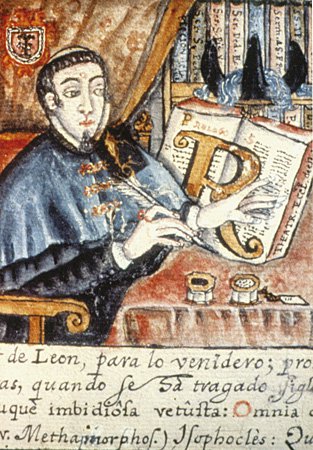Cultural Center of the Philippines
ENCYCLOPEDIA OF
PHILIPPINE ART
Anales Eclesiasticos de Filipinas
(Ecclesiastical Annals of the Philippines) / Illuminations (water-based pigments on paper) / Approximately 4-8 sq cm / Unknown artist (active ca 1770-1830) / Archives of the Archdiocese of Manila
The Anales is a handwritten work that deals with the history of the Roman Catholic Church in the Philippines. It consists of two volumes, only the first of which contains profuse illuminations on almost every page. The first volume, containing 523 pages, is 40 x 26.7 cm. The text of the pages measure 35.6 x 17.8 cm. The amanuensis, who was in all probability also the illuminator, is unknown. However, the authority and book lover who commissioned him is believed to be Francisco Diaz de Durana, canon of the Metropolitan Church of Manila in the late 18th century. The initials “FD,” which might refer to him, are stamped on the cover of the first volume. The text was written in ink, using a quill. The miniatures were executed with quills and brushes, ink and water-based colors.
The Anales is not just a personal recapitulation of events; it also contains transcriptions of pontifical bulls and briefs, royal cedulas, orders from the Audiencia, and decrees of governors and archbishops. The narration ends in 1682, during the deanship of Miguel Ortiz de Cobarrubias, which suggests that the 18th-century amanuensis was actually asked to transcribe and illuminate Cobarrubias’s 17th-century manuscript. The largest miniatures, measuring an average of eight sq cm, embellish the capital of the lead sentence of a chapter as well as that of the section announcing the term of a new bishop. Smaller miniatures and colored, artistically designed words add visual variety to the pages. A few pictures, apparently unfinished, are drawn only in black and red, with inscriptions stating what colors should be applied on certain areas, like azul or blue, verde or green.
The miniatures in the Anales presage the letras y figuras (letters and figures), a genre popular in the 1840s. Jose Honorato Lozano (b. ca 1820 d. ca 1880), the most outstanding painter of letras y figuras, might have seen clerical documents similar to the Anales, which inspired him to adapt the style to names of individuals.
Although not as strictly made to coincide with the contours of human beings, animals, or objects, a few illuminated capitals in the Anales suggest that the illuminators often had such coincidences in mind; thus the legs of the letter “A” in the sentence beginning with “A este” were made to coincide with the two extremes of the configuration depicting a walled city.
Evidently, the illuminator intended his images to depict the theme of the text. A drawing showing a diocesan council illustrates the text referring to the Synod of Manila in 1582. Another, depicting the crucifixion of Franciscan missionaries in Japan in 1597, serves to illustrate the discussion of said event. Full-figure renderings of bishops, wearing surplices and mitres and holding croziers, introduce the start of every episcopal term. A section on the devotion to the Nuestra Señora de Guia at her sanctuary in Ermita is illustrated with a drawing showing the chapel in that place at that time.The drawings in Anales are in the proselyte style, a sensibility so called because the artist’s skills and pictorial devices reflected the mind-set of the Filipino while still perplexed and regaled by the colonial setup and the riveting aspects of the Christian religion. In this stage his style was neither naive nor folk nor primitive. It was medieval, reminiscent of Romanesque illuminations and frescos.
Written by Santiago A. Pilar (1994)
